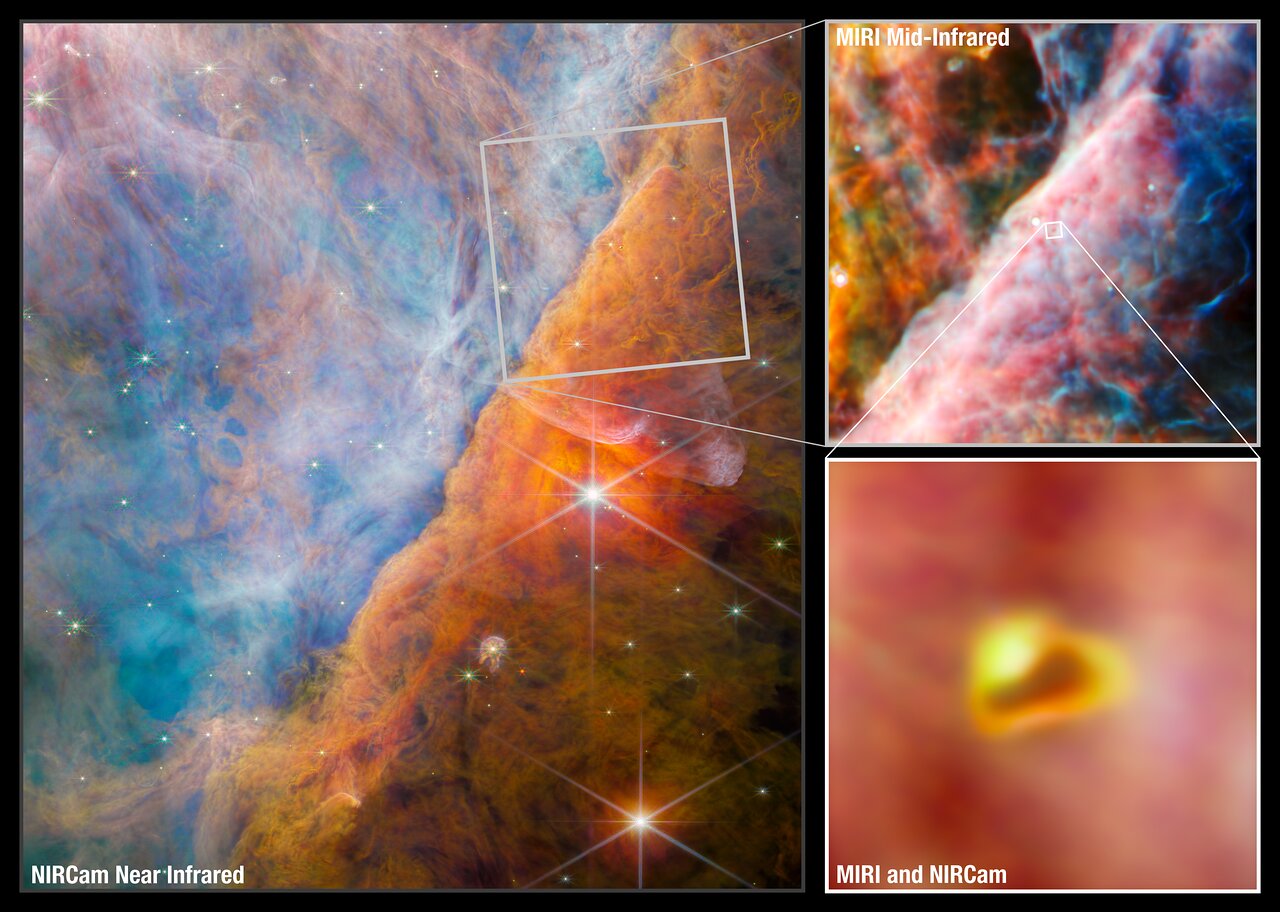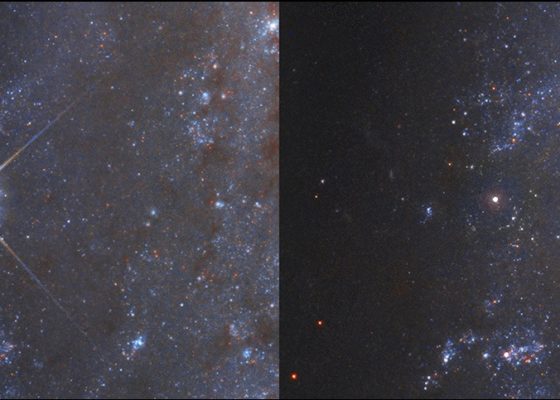
By European Space Agency (ESA), ESA
Carbon compounds form the foundations of all known life, and as such are of a particular interest to scientists working to understand both how life developed on Earth, and how it could potentially develop elsewhere in our Universe. As such, interstellar organic chemistry is an area of keen fascination to astronomers who study the places where new stars and planets form. Molecular ions containing carbon are especially important, because they react with other small molecules to form more complex organic compounds even at low interstellar temperatures . The methyl cation (CH3+) is one such carbon-based ion. CH3+ has been posited by scientists to be of particular importance since the 1970s and 1980s. This is due to a fascinating property of CH3+, which is that it reacts with a wide range of other molecules. This little cation is significant enough that it has been theorised to be the cornerstone of interstellar organic chemistry, yet until now it has never been detected. The unique properties of the James Webb Space Telescope made it the ideal instrument to search for this crucial cation — and already, a group of international scientists have observed it with Webb for the first time. Marie-Aline Martin of Paris-Saclay University, France, a spectroscopist and science team member, explains: “This detection of CH3+ not only validates the incredible sensitivity of James Webb but also confirms the postulated central importance of CH3+ in interstellar chemistry.”
The CH3+ signal was detected in the star-protoplanetary disc system known as d203-506, which is located about 1350 light years away, in the Orion Nebula. Whilst the star in d203-506 is a small red dwarf star, with a mass only about a tenth of the Sun’s, the system is bombarded by strong ultraviolet radiation from nearby hot, young, massive stars. Scientists believe that most planet-forming protoplanetary disks go through a period of such intense ultraviolet radiation, since stars tend to form in groups that often include massive, ultraviolet-producing stars. Fascinatingly, evidence from meteorites suggest that the protoplanetary disc that went on to form our Solar System was also subject to a vast amount of ultraviolet radiation — emitted by a stellar companion to our Sun that has long since died (massive stars burn brightly and die much faster than less massive stars). The confounding factor in all this is that ultraviolet radiation has long been considered to be purely destructive to the formation of complex organic molecules — and yet there is clear evidence that the only life-supporting planet that we know of was born from a disc that was heavily exposed to it.
The team that performed this research may have found the solution to this conundrum. Their work predicts that the presence of CH3+ is in fact connected to ultraviolet radiation, which provides the necessary source of energy for CH3+ to form. Furthermore, the period of ultraviolet radiation experienced by certain disks seems to have a profound impact on their chemistry. For example, Webb observations of protoplanetary disks that are not subject to intense ultraviolet radiation from a nearby source show a large abundance of water — in contrast to d203-506, where the team could not detect water at all. The lead author, Olivier Berné of the University of Toulouse, France, elaborates, “This clearly shows that ultraviolet radiation can completely change the chemistry of a proto-planetary disc. It might actually play a critical role in the early chemical stages of the origins of life by helping to produce CH3+ — something that has perhaps previously been underestimated.”
Although research published as early as the 1970s predicted the importance of CH3+, it has previously been virtually impossible to detect. Many molecules in protoplanetary discs are observed using radio telescopes. However, for this to be possible the molecules in question need to possess what is known as a ‘permanent dipole moment’, meaning that the molecule’s geometry is such that its electric charge is permanently off balance, giving the molecule a positive and a negative ‘end’. CH3+ is symmetrical, and therefore its charge is balanced, and so lacks the permanent dipole moment necessary for observations with radio telescopes. It would theoretically be possible to observe spectroscopic lines emitted by CH3+ in the infrared, but the Earth’s atmosphere makes these essentially impossible to observe from Earth. Thus, it was necessary to use a sufficiently sensitive space-based telescope that could observe signals in the infrared. Webb’s MIRI and NIRSpec instruments were perfect for the job. In fact, a CH3+ detection had previously been so elusive that when the team first saw the signal in their data, they were not sure how to identify it. Remarkably, the team were able to interpret their result within four short weeks, by drawing on the expertise of an international team with a varied range of expertise.
The discovery of CH3+ was possible only through a collaboration among observational astronomers, astrochemical modellers, theoreticians, and experimental spectroscopists, which combined the unique capabilities of JWST in space with those of Earth-based laboratories in order to successfully investigate and interpret our local universe’s composition and evolution. Marie-Aline Martin adds: “Our discovery was only made possible because astronomers, modellers, and laboratory spectroscopists joined forces to understand the unique features observed by James Webb.”










Cancel anytime


Using our website
You may use the The Middle Land website subject to the Terms and Conditions set out on this page. Visit this page regularly to check the latest Terms and Conditions. Access and use of this site constitutes your acceptance of the Terms and Conditions in-force at the time of use.
Intellectual property
Names, images and logos displayed on this site that identify The Middle Land are the intellectual property of New San Cai Inc. Copying any of this material is not permitted without prior written approval from the owner of the relevant intellectual property rights.
Requests for such approval should be directed to the competition committee.
Please provide details of your intended use of the relevant material and include your contact details including name, address, telephone number, fax number and email.
Linking policy
You do not have to ask permission to link directly to pages hosted on this website. However, we do not permit our pages to be loaded directly into frames on your website. Our pages must load into the user’s entire window.
The Middle Land is not responsible for the contents or reliability of any site to which it is hyperlinked and does not necessarily endorse the views expressed within them. Linking to or from this site should not be taken as endorsement of any kind. We cannot guarantee that these links will work all the time and have no control over the availability of the linked pages.
Submissions
All information, data, text, graphics or any other materials whatsoever uploaded or transmitted by you is your sole responsibility. This means that you are entirely responsible for all content you upload, post, email or otherwise transmit to the The Middle Land website.
Virus protection
We make every effort to check and test material at all stages of production. It is always recommended to run an anti-virus program on all material downloaded from the Internet. We cannot accept any responsibility for any loss, disruption or damage to your data or computer system, which may occur while using material derived from this website.
Disclaimer
The website is provided ‘as is’, without any representation or endorsement made, and without warranty of any kind whether express or implied.
Your use of any information or materials on this website is entirely at your own risk, for which we shall not be liable. It is your responsibility to ensure any products, services or information available through this website meet your specific requirements.
We do not warrant the operation of this site will be uninterrupted or error free, that defects will be corrected, or that this site or the server that makes it available are free of viruses or represent the full functionality, accuracy and reliability of the materials. In no event will we be liable for any loss or damage including, without limitation, loss of profits, indirect or consequential loss or damage, or any loss or damages whatsoever arising from the use, or loss of data, arising out of – or in connection with – the use of this website.
Last Updated: September 11, 2024
New San Cai Inc. (hereinafter “The Middle Land,” “we,” “us,” or “our”) owns and operates www.themiddleland.com, its affiliated websites and applications (our “Sites”), and provides related products, services, newsletters, and other offerings (together with the Sites, our “Services”) to art lovers and visitors around the world.
This Privacy Policy (the “Policy”) is intended to provide you with information on how we collect, use, and share your personal data. We process personal data from visitors of our Sites, users of our Services, readers or bloggers (collectively, “you” or “your”). Personal data is any information about you. This Policy also describes your choices regarding use, access, and correction of your personal information.
If after reading this Policy you have additional questions or would like further information, please email at middleland@protonmail.com.
PERSONAL DATA WE COLLECT AND HOW WE USE IT
We collect and process personal data only for lawful reasons, such as our legitimate business interests, your consent, or to fulfill our legal or contractual obligations.
Information You Provide to Us
Most of the information Join Talents collects is provided by you voluntarily while using our Services. We do not request highly sensitive data, such as health or medical information, racial or ethnic origin, political opinions, religious or philosophical beliefs, trade union membership, etc. and we ask that you refrain from sending us any such information.
Here are the types of personal data that you voluntarily provide to us:
As a registered users or customers, you may ask us to review or retrieve emails sent to your business. We will access these emails to provide these services for you.
We use the personal data you provide to us for the following business purposes:
Information Obtained from Third-Party Sources
We collect and publish biographical and other information about users, which we use to promote the articles and our bloggers who use our sites. If you provide personal information about others, or if others give us your information, we will only use that information for the specific reason for which it was provided.
Information We Collect by Automated Means
Log Files
The site uses your IP address to help diagnose server problems, and to administer our website. We use your IP addresses to analyze trends and gather broad demographic information for aggregate use.
Every time you access our Site, some data is temporarily stored and processed in a log file, such as your IP addresses, the browser types, the operating systems, the recalled page, or the date and time of the recall. This data is only evaluated for statistical purposes, such as to help us diagnose problems with our servers, to administer our sites, or to improve our Services.
Do Not Track
Your browser or device may include “Do Not Track” functionality. Our information collection and disclosure practices, and the choices that we provide to customers, will continue to operate as described in this Privacy Policy, whether or not a “Do Not Track” signal is received.
HOW WE SHARE YOUR INFORMATION
We may share your personal data with third parties only in the ways that are described in this Privacy Policy. We do not sell, rent, or lease your personal data to third parties, and We does not transfer your personal data to third parties for their direct marketing purposes.
We may share your personal data with third parties as follows:
There may be other instances where we share your personal data with third parties based on your consent.
HOW WE STORE AND SECURE YOUR INFORMATION
We retain your information for as long as your account is active or as needed to provide you Services. If you wish to cancel your account, please contact us middleland@protonmail.com. We will retain and use your personal data as necessary to comply with legal obligations, resolve disputes, and enforce our agreements.
All you and our data are stored in the server in the United States, we do not sales or transfer your personal data to the third party. All information you provide is stored on a secure server, and we generally accepted industry standards to protect the personal data we process both during transmission and once received.
YOUR RIGHTS/OPT OUT
You may correct, update, amend, delete/remove, or deactivate your account and personal data by making the change on your Blog on www.themiddleland.com or by emailing middleland@protonmail.com. We will respond to your request within a reasonable timeframe.
You may choose to stop receiving Join Talents newsletters or marketing emails at any time by following the unsubscribe instructions included in those communications, or you can email us at middleland@protonmail.com
LINKS TO OTHER WEBSITES
The Middle Land include links to other websites whose privacy practices may differ from that of ours. If you submit personal data to any of those sites, your information is governed by their privacy statements. We encourage you to carefully read the Privacy Policy of any website you visit.
NOTE TO PARENTS OR GUARDIANS
Our Services are not intended for use by children, and we do not knowingly or intentionally solicit data from or market to children under the age of 18. We reserve the right to delete the child’s information and the child’s registration on the Sites.
PRIVACY POLICY CHANGES
We may update this Privacy Policy to reflect changes to our personal data processing practices. If any material changes are made, we will notify you on the Sites prior to the change becoming effective. You are encouraged to periodically review this Policy.
HOW TO CONTACT US
If you have any questions about our Privacy Policy, please email middleland@protonmail.com
The Michelin brothers created the guide, which included information like maps, car mechanics listings, hotels and petrol stations across France to spur demand.
The guide began to award stars to fine dining restaurants in 1926.
At first, they offered just one star, the concept was expanded in 1931 to include one, two and three stars. One star establishments represent a “very good restaurant in its category”. Two honour “excellent cooking, worth a detour” and three reward “exceptional cuisine, worth a
Thank you for your participation,
please Log in or Sign up to Vote

123Sign in to your account
The Real China Model